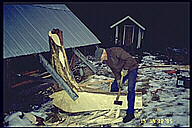 The initiator and leader of the Rus-project, Fredrik Koivusalo, started the building of this ship in autumn 1991. His own courtyard functioned as a shipyard. By and by a varying amount of volunteers joined the work. A company was started for the material investments and an association was founded for arranging the journeys.
The initiator and leader of the Rus-project, Fredrik Koivusalo, started the building of this ship in autumn 1991. His own courtyard functioned as a shipyard. By and by a varying amount of volunteers joined the work. A company was started for the material investments and an association was founded for arranging the journeys.The chronic lack of money forced us to use simple, practical and down-to-earth solutions during the work. This was not in conflict with a thousand-year-old way of thinking, and in fact, this lack of money brought us nearer the real handicraft spirit we needed in the project. One had to take the axe in ones hand and do the things as the forefathers did. There were no practical possibilities to build the ship of oak as the Lapuri ship is made of. We used local Finnish spruce with consideration for the different properties of oak and spruce.
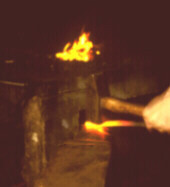 The ship was built outdoors. The movement from minus 25 °C in the boatyard to plus 50 °C in the smithy, where the nails were made, characterizes the contrasts and suffering we had to go through during the project.
The ship was built outdoors. The movement from minus 25 °C in the boatyard to plus 50 °C in the smithy, where the nails were made, characterizes the contrasts and suffering we had to go through during the project.
The ropes for the ship we made of horse hair. Three sails, two of linen and one of wool, were made. The production of a genuine woollen sail proved to be a gigantic project and was not fulfilled until 1994. The hand-woven sail was traditionally impregnated with horse fat, bark-solution and tar - a wonderful product.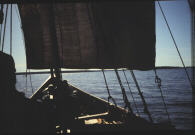
We should try to put ourselves in the Viking seafarer´s life in order to be able to understand what he wanted his ship to be like. Our mechanized world has distanced us from a closeness to nature which characterized the Viking way of thinking. The Viking needed a means for travelling long distances. He needed a ship which was so simple that it was manageable with only the help of the crew in all situations that were likely to occur far from the home harbour.
You had to be able to row the ship fast when required and the crew had to be able to pull it up on land in order for repairs to be carried out. This demanded a light construction which could nevertheless stand rough seas when bad weather caught them unawares. The crew´s muscle power and the wind were the only things available for the ship´s forward momentum.
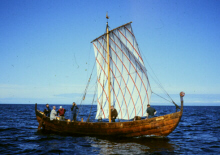 The Viking seafarer´s way of looking at boats was radically different from the way in which modern boat-builders look at them. In constructing his boat, the Viking tried to work with the forces of nature, whereas the modern boat-builder often tries to control nature and work against it.
The Viking seafarer´s way of looking at boats was radically different from the way in which modern boat-builders look at them. In constructing his boat, the Viking tried to work with the forces of nature, whereas the modern boat-builder often tries to control nature and work against it.
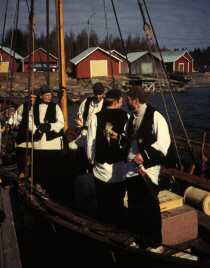
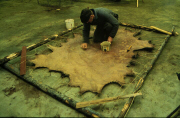 In order to experience the life of the ancient seafarer more authentically, we dressed in sheepskin rugs, slept on fells of elk, ate Viking food from wooden vessels and drank beer from horns. We had no money to buy things with so we hunted and flayed the elks and curried the fells ourself. All wooden barrels and vessels were also produced by us.
In order to experience the life of the ancient seafarer more authentically, we dressed in sheepskin rugs, slept on fells of elk, ate Viking food from wooden vessels and drank beer from horns. We had no money to buy things with so we hunted and flayed the elks and curried the fells ourself. All wooden barrels and vessels were also produced by us.
In a Viking ship you live closer to the elements and you sail on the conditions of nature. Modern people are dependent on schedules and effectivity, and are influenced by an upscrewed media culture. They have difficulties in adapting to the forces of nature. This causes many problems.
The influence of sponsors is in conflict with the life style of the Vikings. In fact, sponsors have not been very interested in us. We are too troublesome and disorderly.
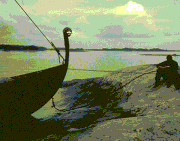
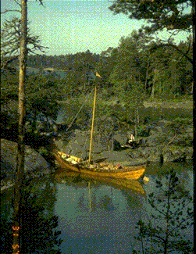 Sailing in a Viking ship is an exciting experience. The low deep-drawing gives us a freedom that is not possible with other types of ships. With a Viking ship you can run ashore almost wherever you want and raid deep into coves and far up rivers. Besides, it is cheaper to travel with a Viking ship.
Sailing in a Viking ship is an exciting experience. The low deep-drawing gives us a freedom that is not possible with other types of ships. With a Viking ship you can run ashore almost wherever you want and raid deep into coves and far up rivers. Besides, it is cheaper to travel with a Viking ship.
In 1994 we planned to sail along the Russian rivers but the Russian authorities did not permit this. Instead we made a long cruise on the Baltic Sea. See planned route.
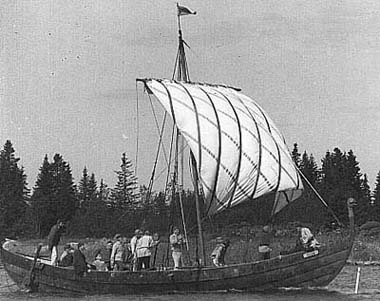 Sailing during the Viking age was not without risk and there are risks even nowadays. If you want to spend a safe and secure life then you should not go on board a Viking ship. On Midsummer Eve our ship was wrecked outside the Latvian coast, in the strait to the Riga bay. This strait was notorious already during the Viking age because of its danger for seafarers. Our rough sailing style gave us information about the life of the ancient seafarers and their vessels, which few modern Viking ship sailers have obtained.
Sailing during the Viking age was not without risk and there are risks even nowadays. If you want to spend a safe and secure life then you should not go on board a Viking ship. On Midsummer Eve our ship was wrecked outside the Latvian coast, in the strait to the Riga bay. This strait was notorious already during the Viking age because of its danger for seafarers. Our rough sailing style gave us information about the life of the ancient seafarers and their vessels, which few modern Viking ship sailers have obtained.
The badly damaged hull was burned when it drifted ashore. Photos of the wreck. The voyage and the wrecking are in detail depicted in the book The Rus Project, which is available in English (sold out), Swedish and Finnish. See literary production.
While we lost this ship, the Rus project stayed alive and we built a new ship, which got the name Heimløsa Rus. This ship conquered Europe. - Navigare necesse est, vivere non est necesse.
| Lapuri find | Heimløsa Rus replica | voyages in 1996-97 | voyage in 1998 | voyage in 1999 | literary production | main page |